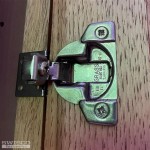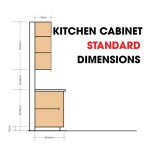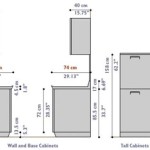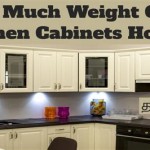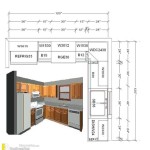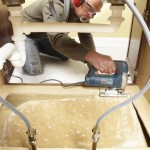How Much Does it Cost to Laminate Kitchen Cabinets?
Laminating kitchen cabinets is a popular option for homeowners looking to update their kitchen's aesthetic without the expense of replacing the entire cabinetry system. The process involves applying a decorative laminate layer to the existing cabinet surfaces, effectively revitalizing their appearance. Understanding the costs associated with this process is crucial for budgeting and making informed decisions. This article explores the various factors that influence the price of laminating kitchen cabinets, providing a detailed overview to assist homeowners in their planning.
The cost of laminating kitchen cabinets is not a fixed figure and is subject to significant variations. Several elements contribute to the final price tag, including the size of the kitchen, the type of laminate chosen, the complexity of the cabinet design, and whether the homeowner opts for professional installation or a do-it-yourself approach. This article will delve into each of these factors, offering insights into how they impact the overall cost.
One of the primary considerations is the size of the kitchen. A larger kitchen naturally contains more cabinets, which translates to a greater surface area to be laminated. This increase in surface area directly correlates to higher material costs and potentially longer labor hours if a professional is hired. Conversely, a smaller kitchen with fewer cabinets will generally result in a lower overall cost.
The choice of laminate material also plays a significant role. Laminates are available in a wide range of qualities and designs, each with its own price point. Basic, standard laminates are generally the most affordable, while higher-end options, such as those with more intricate patterns, textures, or enhanced durability, will command a premium price. The homeowner must carefully weigh their aesthetic preferences against their budgetary constraints when selecting the laminate material.
Furthermore, the complexity of the cabinet design can influence the cost. Cabinets with intricate detailing, raised panels, or curved surfaces require more time and skill to laminate properly. This added complexity can increase labor costs if a professional is employed. Simpler, flat-faced cabinets are easier to laminate and will generally be less expensive.
Finally, the decision to hire a professional installer or undertake the project as a do-it-yourself endeavor will significantly impact the overall cost. Professional installation involves labor costs, which can vary depending on the installer's experience, location, and the scope of the project. A do-it-yourself approach can save on labor costs, but it requires the homeowner to have the necessary skills, tools, and time to complete the project successfully. It also carries the risk of errors that can lead to increased material costs and potentially necessitate professional intervention to correct.
Key Point 1: Material Costs and Laminate Types
The type of laminate chosen is a crucial determinant of the final cost. Laminates are categorized based on their composition, durability, and aesthetic qualities. High-Pressure Laminate (HPL) is a common choice, known for its durability and resistance to scratches, heat, and moisture. It is typically more expensive than Low-Pressure Laminate (LPL), which is commonly used in ready-to-assemble furniture. Thermofoil, another option, is a type of laminate that is heat-sealed onto the cabinet surface, creating a seamless and durable finish. The cost of thermofoil can vary depending on the thickness and quality of the material.
Beyond the basic types, laminates are available in a vast array of colors, patterns, and textures. Some laminates mimic the appearance of natural wood, stone, or metal, offering a cost-effective alternative to using these materials. The price of these specialty laminates can be significantly higher than standard options. Additionally, features such as antimicrobial coatings or enhanced UV resistance can also increase the cost of the laminate.
When calculating material costs, it is essential to consider the amount of laminate needed to cover all the cabinet surfaces. Accurate measurements are crucial to avoid purchasing excess material or running short during the installation process. Waste is inevitable, particularly when dealing with cabinets of varying sizes and shapes, so it is prudent to factor in a margin of error when estimating the required quantity of laminate.
Aside from the laminate itself, other materials may be required, such as adhesive, edge banding, and cleaning supplies. The choice of adhesive is particularly important, as it will determine the bond between the laminate and the cabinet surface. High-quality adhesives are essential for ensuring a long-lasting and durable finish. Edge banding is used to cover the exposed edges of the laminated cabinets, providing a clean and professional look while also protecting the edges from damage.
Key Point 2: Labor Costs and Professional Installation
Opting for professional installation adds labor costs to the overall project budget. The price of labor can vary depending on several factors, including the installer's experience, location, and the complexity of the project. Experienced installers with a proven track record typically charge higher rates than less experienced installers.
Location also plays a role in labor costs. In areas with a higher cost of living, labor rates tend to be higher. Furthermore, the demand for skilled installers can also influence prices. If there is a high demand and limited supply of installers, prices may be driven up.
The complexity of the project is another factor that affects labor costs. Laminating cabinets with intricate detailing or unusual shapes requires more time and skill, which translates to higher labor charges. The condition of the existing cabinets can also impact labor costs. If the cabinets are damaged or require extensive preparation, such as sanding or filling holes, the installer may charge extra for these additional tasks.
When obtaining quotes from professional installers, it is essential to get a detailed breakdown of the costs. This should include the cost of labor, materials (if the installer is providing them), and any other associated fees, such as travel expenses or disposal fees. It is also crucial to inquire about the installer's experience, qualifications, and insurance coverage. A reputable installer should be able to provide references and proof of insurance.
Before hiring an installer, it is advisable to obtain multiple quotes from different providers. This will allow the homeowner to compare prices and services and choose the best option for their needs and budget. It is important to remember that the lowest price is not always the best option. Consider the installer's experience, reputation, and quality of work when making a decision.
Key Point 3: DIY Considerations and Potential Savings
Undertaking the lamination project as a do-it-yourself endeavor can potentially save on labor costs. However, it is essential to carefully consider the skills, tools, and time required to complete the project successfully. Laminating cabinets is not a particularly difficult task, but it does require attention to detail and a certain level of skill.
Before embarking on a DIY project, it is crucial to assess one's skills and experience. If the homeowner has no prior experience with woodworking or similar projects, it may be wise to hire a professional installer. Mistakes can be costly, and repairing or correcting errors can negate any potential savings from doing it yourself.
DIY projects require the right tools. Basic tools include a measuring tape, a utility knife, a straight edge, a roller, and adhesive. More specialized tools, such as a laminate trimmer and a router, can improve the quality of the finish. If the homeowner does not already own these tools, they will need to factor in the cost of purchasing or renting them.
Time is another important consideration. Laminating cabinets can be a time-consuming process, especially for those with limited experience. The homeowner must allocate sufficient time to complete the project without rushing, as rushing can lead to mistakes and a subpar finish. Preparing the cabinets, cutting the laminate, applying the adhesive, and trimming the edges all take time.
Even with careful planning and execution, DIY projects can sometimes encounter unforeseen challenges. Problems such as bubbles, wrinkles, or misaligned edges can arise. If the homeowner is unable to resolve these issues themselves, they may need to hire a professional to correct the mistakes, which can add to the overall cost. It is important to factor in this potential risk when deciding whether to undertake the project as a do-it-yourself endeavor.
In conclusion, the cost of laminating kitchen cabinets is influenced by a complex interplay of factors. Understanding these factors – including material costs, labor costs, and the potential savings and risks associated with a DIY approach – is essential for developing a realistic budget and making informed decisions regarding kitchen renovation. Careful planning, accurate measurements, and a realistic assessment of skills and time commitments are crucial for ensuring a successful and cost-effective outcome.

Laminate Kitchen Cabinets Pictures Options Tips Ideas

Custom Laminate Kitchen Cabinet Doors Magic

Custom Laminate Kitchen Cabinet Doors Magic

Laminate Kitchen Cabinets Jpg

Laminate Cabinets Metropolitan

Laminate Kitchen Cabinets Pros And Cons

7 Maintenance Free Laminate Kitchens That Look Just Like Wood

Laminate Kitchen Cabinets Pros And Cons

Re Laminate Over Existing Cabinet Jennings

Contemporary Laminate Kitchen Cabinets Diamond

